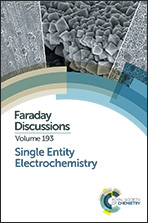Electrochemistry at single molecule occupancy in nanopore-confined recessed ring-disk electrode arrays
Abstract
Electrochemical reactions at nanoscale structures possess unique characteristics, e.g. fast mass transport, high signal-to-noise ratio at low concentration, and insignificant ohmic losses even at low electrolyte concentrations. These properties motivate the fabrication of high density, laterally ordered arrays of nanopores, embedding vertically stacked metal–insulator–metal electrode structures and exhibiting precisely controlled pore size and interpore spacing for use in redox cycling. These nanoscale recessed ring-disk electrode (RRDE) arrays exhibit current amplification factors, AFRC, as large as 55-fold with Ru(NH3)62/3+, indicative of capture efficiencies at the top and bottom electrodes, Φt,b, exceeding 99%. Finite element simulations performed to investigate the concentration distribution of redox species and to assess operating characteristics are in excellent agreement with experiment. AFRC increases as the pore diameter, at constant pore spacing, increases in the range 200–500 nm and as the pore spacing, at constant pore diameter, decreases in the range 1000–460 nm. Optimized nanoscale RRDE arrays exhibit a linear current response with concentration ranging from 0.1 μM to 10 mM and a small capacitive current with scan rate up to 100 V s−1. At the lowest concentrations, the average pore occupancy is 〈n〉 ∼ 0.13 molecule establishing productive electrochemical signals at occupancies at and below the single molecule level in these nanoscale RRDE arrays.
- This article is part of the themed collection: Single Entity Electrochemistry

 Please wait while we load your content...
Please wait while we load your content...